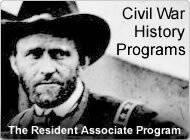
Passover in a Civil War Camp, by Judith Dormann
The Smithsonian Associates Civil War E-Mail Newsletter, Volume 1, Number 6
Religion played an important role in the lives of most Civil War soldiers. And during holidays like Easter and Christmas, they tried to preserve their family traditions as much as they could. This was important also for the Jewish Civil War soldier, of which there were many thousands fighting on both sides.
Passover is the annual Jewish celebration commemorating the Hebrews' escape from slavery under the Egyptian Pharaohs many centuries ago. So, how would it be possible to hold a Passover Seder dinner in the middle of a Civil War, far away from home? It would not be easy to obtain the items needed to celebrate the Jewish Passover, but this is a story of a few who did.
J. A. Joel of the 23rd Ohio Volunteer Regiment was in winter quarters at Fayette, West Virginia. He and about twenty of his fellow Jewish soldiers obtained permission to observe Passover, and so they tried to organize a Seder dinner. The challenge would be to gather all the symbolic items traditionally used to observe the holiday properly. They arranged for the camp sutler to send seven barrels of matzoh (unleavened bread) and prayer books. Then, the soldiers foraged for the remaining necessary items: wine, lamb, chickens, eggs, horseradish and charoses. Obviously, it would be difficult to find all these things in winter quarters. But "Yankee ingenuity" prevailed. They already had the matzoh. (Unleavened bread is used to symbolize the quick escape from Egypt--unable to wait until the bread rose, they took it and used it unleavened). They found kegs of cider to use in place of wine, the symbol of rejoicing. They found lamb, representing the Paschal sacrifice. Instead of horseradish to represent the bitterness of slavery, they substituted: "horseradish we could not obtain, but in lieu we found a weed whose bitterness, exceeded anything our forefathers 'enjoyed'." Charoses is a sweet concoction of apples, wine, and nuts and is used to represent brick mortar because the Hebrews were forced to make bricks during their slavery in Egypt. Instead, the men of the 23rd Ohio had an actual brick on the Seder table, which they contemplated during the meal. And, if tested, they believed it would probably be closer to the texture of the sweet charoses than their usual ration of hard tack. This make-shift Passover Seder went according to tradition and the men were satisfied with their efforts--until they discovered the cider was more like wine than they thought. As Joel writes, "the consequence was a skirmish, with nobody hurt."
He continues, "There in the wild woods of West Virginia, away from home and friends, we consecrated and offered our prayers and sacrifice... There is no occasion in my life that gives me more pleasure and satisfaction than when I remember the celebration of Passover of 1862." And it was all possible because of Yankee ingenuity.

